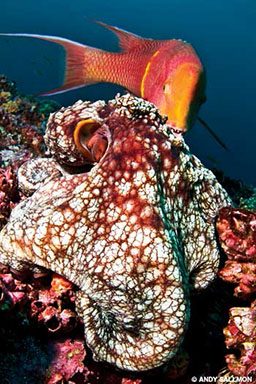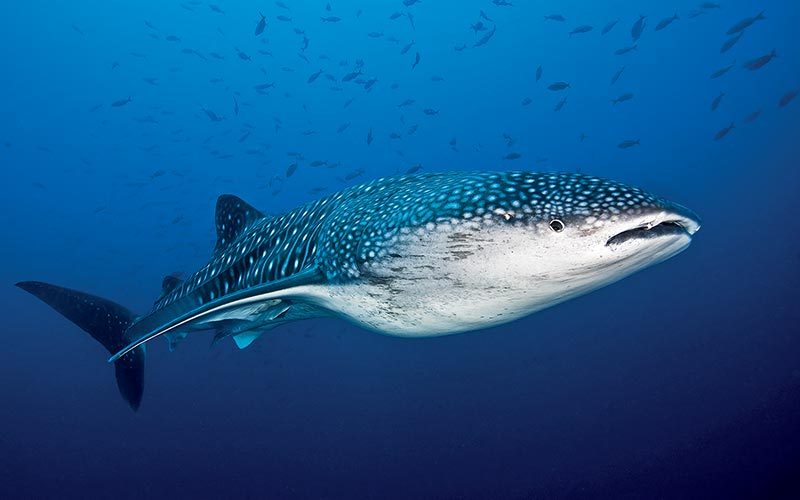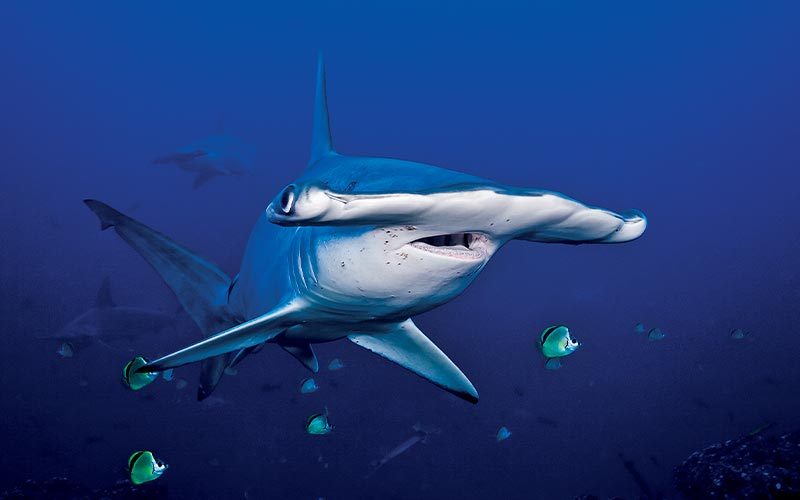Our timing was perfect. We held tightly to the rocks, trying to keep a low profile in the current washing over the seamount. A large school of scalloped hammerheads swam overhead, graceful against a backdrop of misty blue water. As if confirming the “religious experience” status of the dive, dozens of individual sharks dropped down to our level, giving us a close-up look at one of the most alien-appearing animals in the ocean. Glancing backward over my shoulder, I noticed an unexpected visitor: an approaching whale shark, only 15 feet away.

I released my grasp on the rocks and drifted down current toward the newcomer, anticipating his immediate departure. Instead, he circled me curiously, playfully, almost puppylike. I shouted toward the other divers, who continued to stare obliviously at the hammerheads. Minutes ticked by as I alternated screaming to the unaware divers below and giggling delightedly to myself as I acquired as many whale shark photos as would fit on my camera’s memory card. My solo interaction with this young giant continued unnoticed until the divemaster signaled the group to begin their ascent. At this point, the whale shark was promptly pursued by a horde of scary-looking bubble-blowers, and he fled the scene.
My interaction resulted in a decidedly cool postdive reception. As I climbed into the skiff, my dive buddies greeted me with groans and boos, and someone pelted me with a wet towel. Despite the tough crowd, I was unable to wipe the enthusiastic grin off my face until I heard a hushed threat about my camera being thrown overboard. Although I had scored some amazing shots, perhaps my trip hadn’t gotten off to the greatest start popularity wise.
My fellow passengers didn’t stay angry with me for long, however. By the end of the week nearly everyone had been treated to a whale shark interaction. Anywhere else in the world, this might seem unbelievable, but in Cocos, pelagic interactions like this are commonplace. You really need only one word to sum up Cocos Island and its underwater offerings: wild!
Island of the Sharks — and So Much More

When filmmakers Howard and Michele Hall were tasked with choosing the location for their 1999 IMAX film Island of the Sharks, they looked for a place that was utterly shark-infested. Enter Cocos Island, described by Howard Hall as containing “more sharks per cubic meter of salt water than anywhere in the world.” Despite El Niño-related weather snafus, the Halls managed to capture mind-blowing shark footage. However, the resultant film also contains extraordinary sequences of nonshark subjects. Schooling fish, bottlenose dolphins, marlin, marbled rays, mantis shrimp and eels all play strong supporting roles. Sharks aside, Cocos’ waters contain an abundance of fascinating (and fabulously photogenic) marine life.
Cocos Island is a tiny speck in the middle of the Eastern Pacific, located more than 300 miles from mainland Costa Rica. A 30-hour boat ride is required under the most favorable conditions simply to view its shoreline from a distance. Of course, Cocos’ isolation is also its biggest strength: Pelagic creatures are regular visitors to these waters. Despite its diminutive size (about 10 square miles), one would be hard-pressed to find a more amazing place. It rises steeply out of the Pacific, consisting of cloud-topped cliffs covered with lush, green vegetation and careening waterfalls. Jacques Cousteau called this place “the most beautiful island in the world.” Cocos is also rumored to be the inspiration for Jurassic Park‘s Isla Nublar as well as Robert Louis Stevenson’s Treasure Island. Legend has it that Cocos is the site of a horde of buried pirate treasure, though no booty has ever been discovered here.

Unlike many bucket-list dive destinations, Cocos is in no way reminiscent of a beer commercial. Sunny, white-sand beaches lapped by warm, gentle surf are not a feature of this feral island. Rather, beaches here are composed of coconut-sized rocks rimmed by large, crashing swell, and with an average annual precipitation of more than 275 inches, rain is a probability that cannot be avoided. Many Cocos veterans actually prefer to travel here during the rainy season, when cool upwelling from deep water provides sharks with ideal metabolic conditions. For some visitors, this season is not as attractive, because other features of the rainy season include multiple thermoclines, cool water temperatures, variable visibility and swelling, surging seas. Cocos has a wild reputation to uphold, after all, and this means untamed conditions both above and below the ocean’s surface. Divers tend to find it easy to forgive this caveat when they find themselves looking up at a school of hundreds of scalloped hammerhead sharks.
Anything But Tame

Most visitors get their introduction to the diving here at Manuelita, a small islet at the north end of Cocos Island. The protected, inside sites of Manuelita offer coral gardens in shallow, calm water with minimal current. Divers are still treated to a fantastic sampling of marine life, including whitetip reef sharks by the dozen, orange frogfish, schools of trevally and snapper, sea turtles and marbled rays. In recent years people have even reported seeing tiger sharks here, making for orientation dives that are anything but tame. The exposed backside of Manuelita offers a more classic Cocos experience — its steep, boulder-strewn slope is home to many cleaning stations, attracting scalloped hammerhead and silky sharks. A resident school of horse-eye jacks and the occasional manta ray flyby make watching the blue easy to do. Manuelita is also the typical site for spooky night dives: Whitetip reef sharks, already abundant during the daylight, gather in huge tangles of teeth, fins and tails once the sun sets, using divers’ lights to help them locate their prey.
Once visiting divers are acclimated to the conditions at Cocos, divemasters will begin introducing them to some of the more advanced signature sites. One example is guano-covered Dirty Rock (Roca Sucia) on the north side of Cocos Island. This jagged pinnacle rises 15 odiferous feet above the ocean surface, but its underwater features provide a stark contrast to its unappealing topside appearance. On one visit, I backrolled directly into a huge, churning baitball complete with feeding yellowfin tuna and bottlenose dolphins. It was so dense and distracting I could easily have spent an entire dive concentrating my photographic efforts on it. As with many Cocos dives, this pinnacle’s steep walls reveal cleaning stations frequented by hammerheads, silkies and the occasional fat Galapagos shark. A short swim away lies an adjacent pinnacle that tops off at 60 feet and is a great place to view lobster, turtles and the massive resident school of horse-eyed jacks that often swirls overhead.
Silverado, to the east, is so named because of the silvertip reef sharks that sometimes frequent the area. The site consists of a large, submerged rock that rises to within 15 feet of the surface and a gradual, sandy slope that extends into deeper water. This inconspicuous spot is home to some of Cocos’ most bizarre small creatures and can inspire even the most fanatical shark lover (myself included) to become engrossed in examining the sand. Endemic rosy-lipped batfish can be found ambulating across the sea floor using their pectoral fins for propulsion. The sand here also houses mantis shrimp, jawfish and snake eels.
West of Cocos Island is Punta Maria, a football-field-sized seamount rising to within 75 feet of the surface. It’s dotted with cleaning stations and divided centrally by a sand channel — a perfect hiding spot for divers. This is an ideal place to experience close passes by large Galapagos sharks and scalloped hammerheads. Whitetip reef sharks and squadrons of trevally are often seen hunting at a smaller, adjoined pinnacle, and the adjacent deep water is a reliable place to spot schools of snapper and big-eyed soldierfish.

Submerged Rock, which actually breaks the surface at low tide, is a steep-walled pinnacle that lies south of Cocos Island. Descending to 70 feet, divers will discover a truck-sized swim-through housing dense schools of yellow snapper and colorful big-eyed soldierfish as well as lobster and piles of sleeping whitetip reef sharks. Peering off into the blue is worthwhile here as well — on my last visit a marlin flashed past me, pulling my attention from both the swim-through and several passing hammerheads.
Southwest of Cocos are two sloping islets called Dos Amigos. The larger islet, appropriately called Big Dos Amigos, boasts a huge arch-shaped swim-through at a depth of 70 feet that is commonly inhabited by large marbled rays. Both Big Dos Amigos and Small Dos Amigos have numerous, busy hammerhead cleaning stations at depths of about 100 feet. Whitetip reef sharks are always seen here, and divers can also spot eagle rays, hunting trevally and tuna, and schools of jacks or snappers.
The most well-known dive at Cocos is Alcyone, a flat-topped seamount named after Cousteau’s yacht. This challenging, advanced site sits at 90 feet and is surgy and swept by ripping currents. A visit here may be delayed until divemasters feel very confident in divers’ abilities. The depth and current can be daunting, but they bring huge rewards. Schools of scalloped hammerheads are the main attraction at Alcyone, and the cleaning stations here are generally very busy. Unexpected visitors, such as whale sharks, are reported more commonly here than at any other site. There are also plenty of other features here to get your heart pumping — silky sharks, whitetip reef sharks, marbled rays and octopi live on top of the seamount, and large schools of horse-eye jacks and snapper are common.
The last dive of my trip had arrived, and my no-decompression time was dwindling. In my immediate future lay endless photo downloads, packing, a very long boat ride and a multiconnection flight home. I tried not to be depressed as I began my ascent, recalling what our divemaster told us during each briefing: No dive at Cocos is complete until you surface.
As I mentally divided my camera and dive gear into airline-approved, 50-pound parcels, a shape in the distance caught my eye. It grew larger, and as it approached I recognized the now-familiar shape and motion of a whale shark. I left my camera at my side and watched as the huge fish passed within feet of me, then veered off, giving me a Cocos-style farewell that will bring me back again and again.
Dive In

Cocos Island is accessible only by liveaboard dive boats operating out of mainland Costa Rica. The crossing can be rough, so divers prone to seasickness are advised to use preventative measures. All diving is by boat.
Seasons: Conditions at Cocos vary greatly with the season. January to June is the dry season, bringing a greater chance of sunny skies (though showers are still commonplace) and calm seas. July to December is the rainy season, with copious precipitation, generally rougher marine conditions and colder water.
Conditions and Skill Level: Diving is intermediate to advanced due to extreme thermoclines with cool (high 70s°F) water temperatures, changing visibility and strong currents and surge. This is not a destination for new divers.
Gear: A 5mm to 7mm full wetsuit is recommended. Gloves are crucial, since divers are expected to hold onto rocks to maintain position in the current and surge. Surface signaling devices are required.
Cocos Island and Conservation

In 2009 a National Geographic expedition to Cocos Island brought together explorers and marine scientists to record and describe the aquatic habitat. Their data confirmed that the seamounts surrounding the island are home to the largest biomass of predators in the tropical Pacific.
With this report in mind, the Costa Rican government recently expanded Cocos Island National Park’s marine protected area (MPA) to encompass more than 3,700 square miles of ocean, an area larger than Yellowstone National Park. Nevertheless, illegal fishing is rampant. While not surprising, knowledge of the activity does little to buffer divers’ first heartbreaking glimpse of the immense collection of fishing line, gill nets and hooks recovered from Cocos’ waters, viewable during a visit to the ranger station at Wafer Bay.
Passionate surveillance and intervention by the Costa Rican Coast Guard, Área de Conservación Marina Isla del Coco (ACMIC) park rangers and various nonprofit organizations aim to limit fishing pressure and preserve the health of this incredible UNESCO World Heritage Site for future generations.
© Alert Diver — Q1 Winter 2012